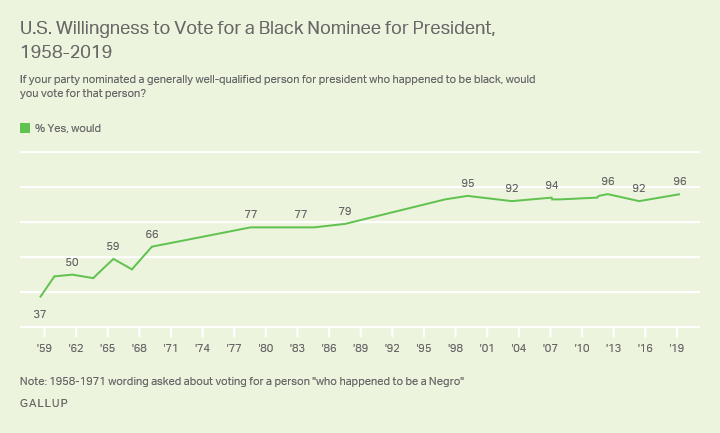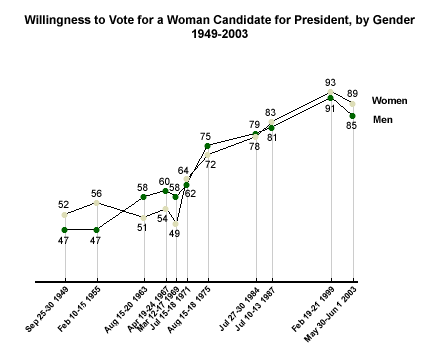Madam POTUS
Critical Analysis
According to the data, in 2020, what percent of Americans said they would be willing to vote for a woman for president?
What story does this chart tell about American’s willingness to vote for a female presidential candidate?
What do you think explains the change in Americans’ willingness to vote for a woman POTUS?
If your party nominated a generally well-qualified person for president who happened to be a woman, would you vote for that person?
Describe how party affiliation impacts voters’ willingness to vote for a female candidate in the chart below.*
Six percent of American voters automatically disqualify any female presidential candidates. What percent of Americans do you believe would automatically disqualify a male presidential candidate; a “white” presidential candidate?
Given the data in the chart, a male presidential candidate would be starting off with a six point head start over any female candidate. Explain whether that alone is reason enough for a political party to automatically reject any female candidate.
Explain what year you predict America will select their first female president (if ever).
Explain why we have had an African-American (or more accurately, a mixed-race) president and not a female president.
Amendment XIX gave all American women the right to vote on August 18, 1920. That was over 100 years ago. Do you think it is surprising that a woman would has not won the presidency since this Amendment is just a century old?
Visual Extension*
Prepare for the 2026 AP® US Government Exam with High Five! Our Exam Review guide is completely redesigned and updated with over 140 pages of great AP Exam review material. Tons of completed graphic organizers are full of information to get you exam-ready in a flash.
This 2026 exam guide is an instant download and contains all the following resources.
Overview of the U.S. Government and Politics exam.
Completed graphic organizers for all required documents + Supreme Court cases.
Guide to the skills and content for all 5 course units.
Essential vocabulary with link to online glossary.
Tons of Graphic Organizers with answers from each course unit.
GoPo Pro Tips and checklists.
Exam review Guides.
Amazing AI generated images of the Framers of the Constitution giving high fives!
Full Length AP multiple choice + Free Response Exam with Key.
AP ® is a trademark registered by the College Board, which is not affiliated with, and does not endorse, this site or product.
GoPoPro does not offer credit or grades for our classes or products.
PREVIEW HIGH FIVE NOW
Learning Extension
Read this great Vox story: Women candidates are constantly asked about their electability. Here are 5 reasons that’s misguided.
Action Extension
In a quartet, trio, or pair (in a breakout room or in person) enter into a respectful discussion about why a woman has never been president and whether a woman ever will win the U.S. presidency. Before you share your opinion, listen both carefully and actively to your partners as they share their opinions. Repeat a summary of their comments back to them when they are done. Share the results of your conversation in class tomorrow.









